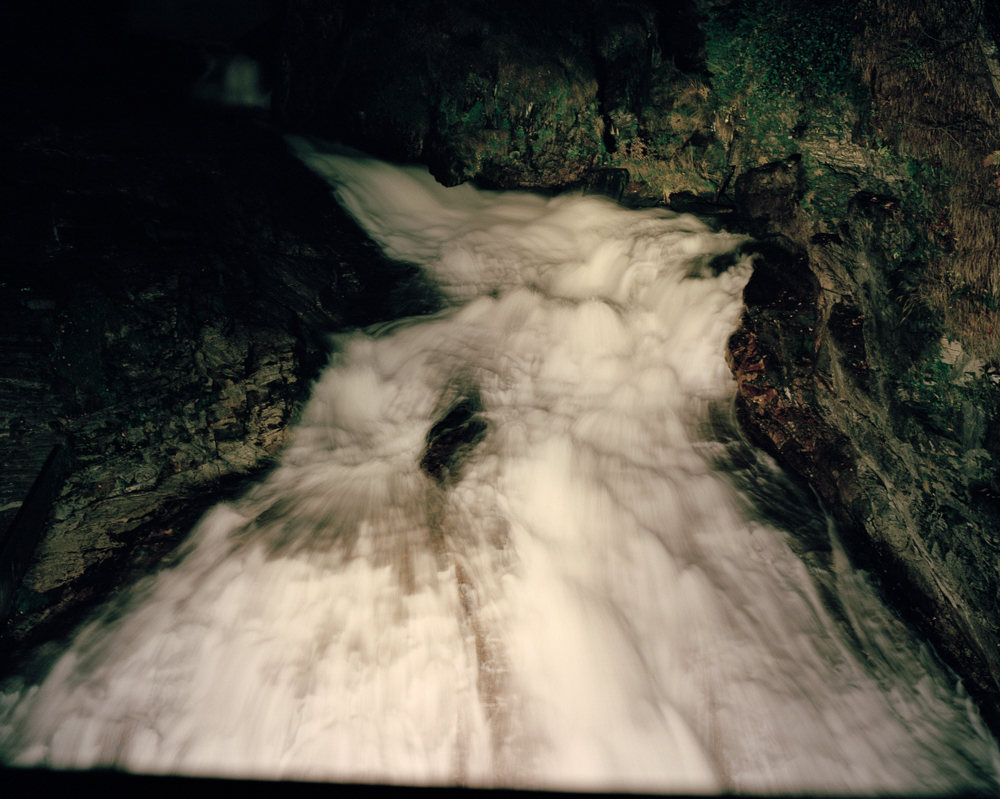Springtime in Bad Gastein, 2017–18
In 1946, at the end of WWII, my grandfather’s life intersected with the lives of 1,250 Jewish refugees in Bad Gastein, an Austrian town hugged by mountains and filled with empty hotels. My grandfather, a Jewish captain in the U.S. army on occupation duty, was suddenly responsible for caring for this group of individuals who came from across Europe, spoke multiple languages, and shared the basic need for a home. His job was organizing refuge in Bad Gastein’s empty hotels. The injustice of having a home to return to when others did not was not lost on my grandfather. Which is, perhaps, why once he was home he wove a tale around this formative experience. He recounted it with such regularity that this Austrian town became mythological and a part of my family’s marrow.
Wanting to get inside this myth, I dug out the photograph of Bad Gastein’s waterfall that I’d acquired from my grandfather while he was living. This image of the waterfall, a central motif in my grandfather’s story, was the portal through which I entered this body of photographic work.
I dissolved the fixed narrative I’d known since childhood through searches in archives and sensitive conversations with family members. Once in Austria, the edges of the story expanded as I burrowed deeper into the town. I snuck into the hotels where the refugees lived, found individuals my grandfather met as children, and dug up earth to find remnants of the building where he stayed. In Austria and back in the studio I visually folded the historical and mythological into the present and used collage to mirror how memories and narratives accrue and morph.
In an effort to try to understand my grandfather’s experience and my own present day circumstances this series revisits this story anew in a moment when there are more people displaced due to conflict and climate change than in any other time in world history, and when a tide of far-right nationalism is on the rise again.
![]()
![]()
![]()
![]()
![]()
![]()
![]()
![]()
![]()
![]()
![]()
![]()
![]()
![]()
![]()
![]()
![]()
![]()
![]()
![]()
![]()
![]()
![]()
![]()
![]()
![]()
In 1946, at the end of WWII, my grandfather’s life intersected with the lives of 1,250 Jewish refugees in Bad Gastein, an Austrian town hugged by mountains and filled with empty hotels. My grandfather, a Jewish captain in the U.S. army on occupation duty, was suddenly responsible for caring for this group of individuals who came from across Europe, spoke multiple languages, and shared the basic need for a home. His job was organizing refuge in Bad Gastein’s empty hotels. The injustice of having a home to return to when others did not was not lost on my grandfather. Which is, perhaps, why once he was home he wove a tale around this formative experience. He recounted it with such regularity that this Austrian town became mythological and a part of my family’s marrow.
Wanting to get inside this myth, I dug out the photograph of Bad Gastein’s waterfall that I’d acquired from my grandfather while he was living. This image of the waterfall, a central motif in my grandfather’s story, was the portal through which I entered this body of photographic work.
I dissolved the fixed narrative I’d known since childhood through searches in archives and sensitive conversations with family members. Once in Austria, the edges of the story expanded as I burrowed deeper into the town. I snuck into the hotels where the refugees lived, found individuals my grandfather met as children, and dug up earth to find remnants of the building where he stayed. In Austria and back in the studio I visually folded the historical and mythological into the present and used collage to mirror how memories and narratives accrue and morph.
In an effort to try to understand my grandfather’s experience and my own present day circumstances this series revisits this story anew in a moment when there are more people displaced due to conflict and climate change than in any other time in world history, and when a tide of far-right nationalism is on the rise again.

























